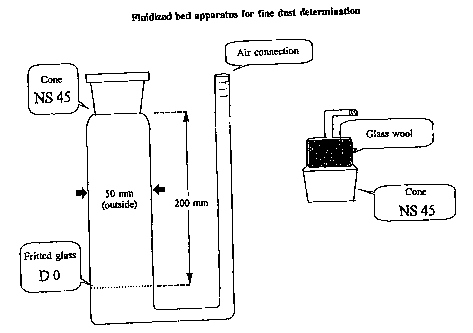Une partie des informations de ce site Web a été fournie par des sources externes. Le gouvernement du Canada n'assume aucune responsabilité concernant la précision, l'actualité ou la fiabilité des informations fournies par les sources externes. Les utilisateurs qui désirent employer cette information devraient consulter directement la source des informations. Le contenu fourni par les sources externes n'est pas assujetti aux exigences sur les langues officielles, la protection des renseignements personnels et l'accessibilité.
L'apparition de différences dans le texte et l'image des Revendications et de l'Abrégé dépend du moment auquel le document est publié. Les textes des Revendications et de l'Abrégé sont affichés :
| (12) Brevet: | (11) CA 2219604 |
|---|---|
| (54) Titre français: | METHODE POUR AMELIORER LA RESISTANCE DE CORPS MOULES A BASE DE ZEOLITE CONTRE L'USURE |
| (54) Titre anglais: | PROCESS FOR IMPROVING THE ABRASION RESISTANCE OF ZEOLITE MOULDED BODIES |
| Statut: | Périmé et au-delà du délai pour l’annulation |
| (51) Classification internationale des brevets (CIB): |
|
|---|---|
| (72) Inventeurs : |
|
| (73) Titulaires : |
|
| (71) Demandeurs : |
|
| (74) Agent: | MARKS & CLERK |
| (74) Co-agent: | |
| (45) Délivré: | 2007-01-09 |
| (22) Date de dépôt: | 1997-10-29 |
| (41) Mise à la disponibilité du public: | 1998-04-30 |
| Requête d'examen: | 2002-10-29 |
| Licence disponible: | S.O. |
| Cédé au domaine public: | S.O. |
| (25) Langue des documents déposés: | Anglais |
| Traité de coopération en matière de brevets (PCT): | Non |
|---|
| (30) Données de priorité de la demande: | ||||||
|---|---|---|---|---|---|---|
|
La résistance à l'usure de corps moulés à base de zéolithe est améliorée en pulvérisant les corps moulés à base de zéolithe d'une sol de silice aqueuse, puis éventuellement en les séchant et en les calcinant.
The abrasion resistance of zeolite moulded bodies is improved by spraying the zeolite moulded bodies with an aqueous silica sol solution and then optionally drying and calcining them.
Note : Les revendications sont présentées dans la langue officielle dans laquelle elles ont été soumises.
Note : Les descriptions sont présentées dans la langue officielle dans laquelle elles ont été soumises.

2024-08-01 : Dans le cadre de la transition vers les Brevets de nouvelle génération (BNG), la base de données sur les brevets canadiens (BDBC) contient désormais un Historique d'événement plus détaillé, qui reproduit le Journal des événements de notre nouvelle solution interne.
Veuillez noter que les événements débutant par « Inactive : » se réfèrent à des événements qui ne sont plus utilisés dans notre nouvelle solution interne.
Pour une meilleure compréhension de l'état de la demande ou brevet qui figure sur cette page, la rubrique Mise en garde , et les descriptions de Brevet , Historique d'événement , Taxes périodiques et Historique des paiements devraient être consultées.
| Description | Date |
|---|---|
| Le délai pour l'annulation est expiré | 2012-10-29 |
| Lettre envoyée | 2011-10-31 |
| Accordé par délivrance | 2007-01-09 |
| Inactive : Page couverture publiée | 2007-01-08 |
| Inactive : Taxe finale reçue | 2006-10-04 |
| Préoctroi | 2006-10-04 |
| Un avis d'acceptation est envoyé | 2006-04-04 |
| Lettre envoyée | 2006-04-04 |
| Un avis d'acceptation est envoyé | 2006-04-04 |
| Inactive : Approuvée aux fins d'acceptation (AFA) | 2006-03-20 |
| Inactive : CIB de MCD | 2006-03-12 |
| Inactive : CIB de MCD | 2006-03-12 |
| Modification reçue - modification volontaire | 2005-10-07 |
| Inactive : Dem. de l'examinateur art.29 Règles | 2005-04-15 |
| Inactive : Dem. de l'examinateur par.30(2) Règles | 2005-04-15 |
| Lettre envoyée | 2002-12-09 |
| Lettre envoyée | 2002-12-05 |
| Exigences pour une requête d'examen - jugée conforme | 2002-10-29 |
| Toutes les exigences pour l'examen - jugée conforme | 2002-10-29 |
| Inactive : Transfert individuel | 2002-10-29 |
| Requête d'examen reçue | 2002-10-29 |
| Lettre envoyée | 2002-01-11 |
| Lettre envoyée | 1999-06-22 |
| Inactive : Transferts multiples | 1999-04-30 |
| Demande publiée (accessible au public) | 1998-04-30 |
| Inactive : CIB attribuée | 1998-02-12 |
| Symbole de classement modifié | 1998-02-12 |
| Inactive : CIB attribuée | 1998-02-12 |
| Inactive : CIB en 1re position | 1998-02-12 |
| Inactive : CIB attribuée | 1998-02-12 |
| Inactive : CIB attribuée | 1998-02-12 |
| Inactive : Certificat de dépôt - Sans RE (Anglais) | 1998-01-23 |
| Lettre envoyée | 1998-01-23 |
| Demande reçue - nationale ordinaire | 1998-01-22 |
Il n'y a pas d'historique d'abandonnement
Le dernier paiement a été reçu le 2006-10-06
Avis : Si le paiement en totalité n'a pas été reçu au plus tard à la date indiquée, une taxe supplémentaire peut être imposée, soit une des taxes suivantes :
Les taxes sur les brevets sont ajustées au 1er janvier de chaque année. Les montants ci-dessus sont les montants actuels s'ils sont reçus au plus tard le 31 décembre de l'année en cours.
Veuillez vous référer à la page web des
taxes sur les brevets
de l'OPIC pour voir tous les montants actuels des taxes.
Les titulaires actuels et antérieures au dossier sont affichés en ordre alphabétique.
| Titulaires actuels au dossier |
|---|
| GRACE GMBH & CO. KG |
| Titulaires antérieures au dossier |
|---|
| ECKEHART ROLAND |
| ELKE KOSSEL |
| FRANK HEINDL |
| OLIVER FEUER |